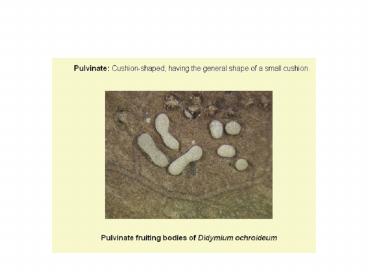Rhizoid Colony Formation PowerPoint PPT Presentation
Title: Rhizoid Colony Formation
1
(No Transcript)
2
Rhizoid Colony Formation
3
Bacillus subtilis. These gram positive,
sporeforming rods produce colonies which are dry,
flat, and irregular, with lobate margins.
4
Pseudomonas aeruginosa. This gram negative rod
forms mucoid colonies with umbonate elevation.
Some strains produce a diffusable green pigment
and a distinctive fruity odor. P. aeruginosa is
an opportunistic contaminant of burn injurys,
wounds such as cuts and gunshot, and can cause
bacterial pneumonia. It is often nosocomial
pathogen, easily transmitted by hands and
invasive medical procedures.
5
Salmonella choleraesuis serovar typhimurium.
This gram negative rod is a component of the
gastrointestinal tract of birds and reptiles and
is an agent of gastroenteritis in humans. It
forms shiny, convex colonies with entire margins.
6
Escherichia coli. This gram negative rod
(coccobacillus) forms shiny, mucoid colonies
which have entire margins and are slightly
raised. Older colonies often have a darker
center.
7
Rhodospirillum rubrum. Pinpoint circular
colonies which are convex with entire margins.
This gram negative spirillum produces a
non-diffusable red pigment.
8
Micrococcus luteus. Circular, pinhead colonies
which are convex with entire margins. This gram
positive coccus produces a bright yellow,
non-diffusable pigment
9
Staphylococcus aureus. Circular, pinhead
colonies which are convex with entire margins.
This gram positive coccus often produces colonies
which have a golden-brown color.
10
Staphylococcus epidermidis. Circular, pinhead
colonies which are convex with entire margins.
The colonies of this gram-positive coccus appear
either the color of the agar, or whitish.
11
Lenticular cloud
12
Lenticular Cloud over Mt. Shasta
13
Lenticular Shaped like a double convex
lens.Lenticular sproangia of Physarum viride
14
Umbonate
15
Colony Edge patterns
16
Pellicle floating on broth
17
Paramecium feeding on flocculent bacterial mass.
18
Filamentous Bacteria in a Hot Spring
19
The End
PowerShow.com is a leading presentation sharing website. It has millions of presentations already uploaded and available with 1,000s more being uploaded by its users every day. Whatever your area of interest, here you’ll be able to find and view presentations you’ll love and possibly download. And, best of all, it is completely free and easy to use.
You might even have a presentation you’d like to share with others. If so, just upload it to PowerShow.com. We’ll convert it to an HTML5 slideshow that includes all the media types you’ve already added: audio, video, music, pictures, animations and transition effects. Then you can share it with your target audience as well as PowerShow.com’s millions of monthly visitors. And, again, it’s all free.
About the Developers
PowerShow.com is brought to you by CrystalGraphics, the award-winning developer and market-leading publisher of rich-media enhancement products for presentations. Our product offerings include millions of PowerPoint templates, diagrams, animated 3D characters and more.

